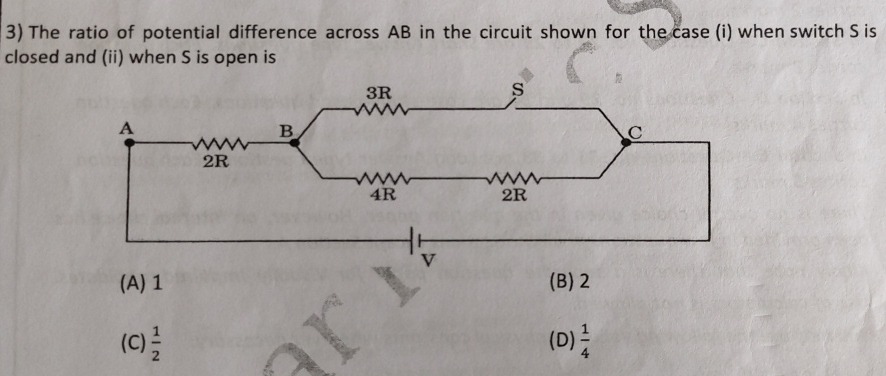Question
Question: The ratio of potential difference across AB in the circuit shown for the case (i) when switch S is c...
The ratio of potential difference across AB in the circuit shown for the case (i) when switch S is closed and (ii) when S is open is

1
2
21
41
2
Solution
Let VAB denote the potential difference across points A and B. Case (ii): Switch S is open When S is open, the branch with the 3R resistor is inactive. The resistors 4R and 2R are in series, so RBC=4R+2R=6R. The total resistance between A and C is RAC=RAB+RBC=2R+6R=8R. The current from C to A is I=8RV. The potential difference across AB is VAB(open)=VA−VB. Current flows from B to A. VB−VA=I×RAB=8RV×2R=4V. So, VAB(open)=−4V.
Case (i): Switch S is closed When S is closed, the 3R resistor is in parallel with the series combination of 4R and 2R (total 6R). The equivalent resistance between B and C is RBCeq=3R+6R3R×6R=9R18R2=2R. The total resistance between A and C is RACeq=RAB+RBCeq=2R+2R=4R. The current from C to A is I=4RV. The potential difference across AB is VAB(closed)=VA−VB. Current flows from B to A. VB−VA=I×RAB=4RV×2R=2V. So, VAB(closed)=−2V.
The ratio of the potential difference across AB in case (i) (S closed) to case (ii) (S open) is: Ratio=VAB(open)VAB(closed)=−V/4−V/2=V/4V/2=2 The question implies the ratio of magnitudes: Ratio of magnitudes=∣VAB(open)∣∣VAB(closed)∣=V/4V/2=2
